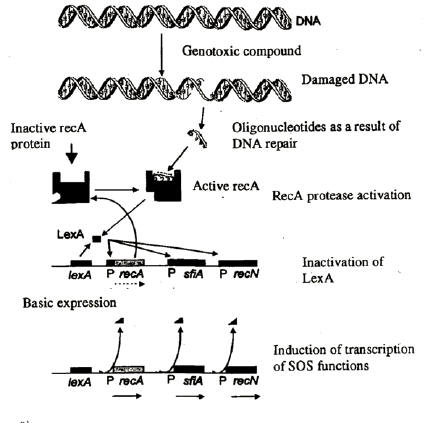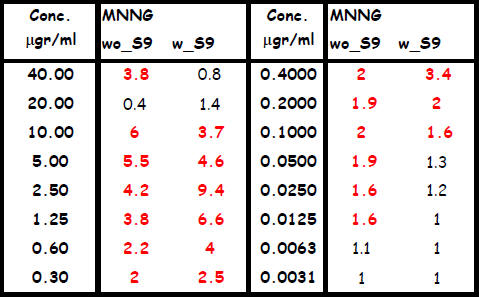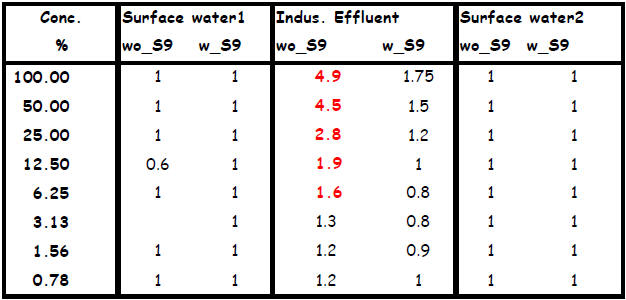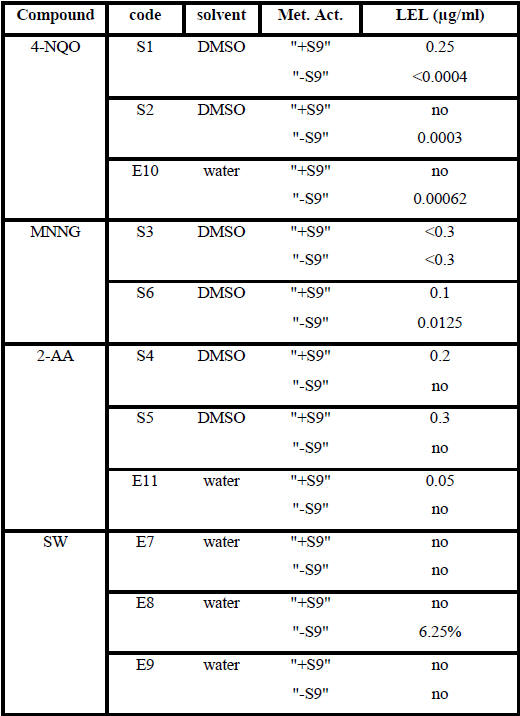Sidebar
|
The VITOTOX test is a test which is more rapid and less expensive than the
“classical” Ames test. The test is also at least as sensitive as the Ames test. It is based on
bacteria that contain the lux operon of Vibrio fischeri under transcriptional control of the recN
gene, that is part of the SOS-system (Scheme 6.1). This gene is normally not transcribed (no
light production) but it will be “switched on” when the bacteria are exposed to a genotoxic
compound (mutagen or “SOS-inducing” substance). Genotoxicity is thus expressed as light
production.

which the VITOTOX test is based (insertion of an operon-less “lux” gene next
to recN results in light production when the bacterial DNA is damaged)
Although any bacterial strain can be used, Salmonella typhimurium strains were chosen as
these are well known for mutagenicity testing and because the same bacteria can also be used
Screening of the Bioactivity of the Isolated Natural Productsfor a classical Ames test.
However, as all Salmonella constructs gave very comparable results,
only the TA104 construct [called T104 (recN2-4)] is used as it was shown to be sometimes a
little bit more sensitive than the other hybrid strains.
As it was realised that some compounds act directly on the light production (e.g., aldehydes)
or enhance the metabolism of the bacteria creating false-positive results, a constitutive light
producing strain with a lux operon under control of the strong promoter pr1 was also
incorporated. This is used as an internal control system, which also gives important
information on the toxicity of the test compound. Major advantages are less sample used, results in 4h.
Is is used in real time with Agilent or LuminMax luminometer.
|
Monitoring genotoxicity during the photocatalytic degradation of p-nitrophenol with VitoTOX on Agilent
|
| M. Shani Sekler 1, Y. Levi 1, B. Polyak 1, A. Novoa 1, P. S. M. Dunlop 2, J. A. Byrne 2, R. S. Marks 1 3 * |
| 1Institute for Applied Biosciences, Ben-Gurion University, PO Box 653, Beer-Sheva 84105, Israel 2NIBEC, University of Ulster at Jordanstown, Newtownabbey, Northern Ireland BT37 0QB, UK 3Department of Biotechnology Engineering, Ben-Gurion University, PO Box 653, Beer-Sheva 84105, Israel |
| email: R. S. Marks (This email address is being protected from spambots. You need JavaScript enabled to view it.) |
*Correspondence to R. S. Marks, Institute for Applied Biosciences, Ben-Gurion University, PO Box 653, Beer-Sheva 84105, Israel.
Funded by:![]() EC; Grant Number: EVKI-CT-2000-00069
EC; Grant Number: EVKI-CT-2000-00069
| photocatalysis • genotoxicity • p-nitrophenol • bioassay |
| p-Nitrophenol is a common structural unit of many pesticides and was chosen as a model compound to monitor genotoxicity during photocatalytic degradation. The genotoxicity of p-nitrophenol (PNP) and its breakdown products was measured using a bioluminescent bacterial bioassay, VitotoxTM. The genotoxic potential decreased with the concomitant photocatalytic degradation of the parent PNP concentration. The rate of genotoxicity reduction was slower than the rate of removal of the parent PNP, due to the formation of genotoxic by-products. After 6 h of photocatalytic treatment the total genotoxicity was removed. These results indicate that bioassays can be used as a simple and highly sensitive method for monitoring the general toxicity of chemical pollutants before, during and after photocatalytic treatment or other destructive processes. Copyright © 2004 John Wiley & Sons, Ltd. |
|
LuminMax-C™ Easy to Use Attomole Luminometer |
||||||||||||||||||||||||||||||||||||||||||||||||||||||||||||||||||||
|
CELL QUANTIFICATION AND ATP TESTS
LuminMax-Q-Cell: Luminescent Cell Viability Assay 155 USD
1 vial LuminMax-ES, Luciferase and Substrate (luciferin) (lyophilized)
10 ml LuminMax-CB, Cell Buffer
100µl per assay (microwell),
the material is sufficient for 100 assays in 96-well plate
ATP: for Sensitivity and Standard Tests 175 USD
1 vial (400 µl, 100mM)
20µl for a series of dilution for a standard (calibration) test,
the material is sufficient for standard tests for 20 times
- The lyophilized LuminMax-ES and Cell Buffer should be stored at -20oC for
long-term (over one week) storage. For frequent use, it can be stored at 4oC;
however, it may lose some activity.
ATP Assay Protocol:
Purpose: To generate ATP standard curve
Material:
1. ATP 100mM
2. LuminMax-CB buffer
3. LumiMax-ES substrate (lyophilized)
4. Bottom clear 96 well microplate or strip: Must be compatible with the luminometer
5. Nuclease-free water
Reagent Preparation:
1. Thaw the LuminMax-CB Buffer and equilibrate to room temperature prior to use.
2. Equilibrate the lyophilized LuminMax-ES Substrate to room temperature prior to
use.
3. Transfer the appropriate volume of Buffer into the bottle containing Substrate to
reconstitute the lyophilized enzyme/substrate mixture. This is the Quantitative
Cell (or Signal) Reagent.
Experiment:
1. Prepare 1uM ATP in culture medium, buffer or nuclease-free water.
(100µl of 1µM ATP solution contains 10-10 moles ATP).
2. Prepare tenfold serial dilutions of ATP in culture medium, buffer or nuclease-free
water (e.g. 1µM to 10nM). (Dilute further for sensitivity test of the luminometer.)
3. Dispense 100µl of ATP solutions in microwell plate.
4. Add a volume of Q-Cell reagent equal to the volume of ATP.
5. Mix contents for 2 minutes on a shaker.
6. Incubate the plate at room temperature for 5 or 10 minutes.
7. Read luminescence with integration time of 100 ms or 1.0 second.
Example of ATP Standard Curve Assay
|
Purpose: To Evaluate sensitivity with ATP assay using LuminMax-C |
||||||||
|
Material: |
||||||||
|
1. ATP: 100mM, 400ul, store at -20C, thawed, Store 4C. |
||||||||
|
Prepare (1)20ul + 1.98ml nuclease-free water = 1mM; |
||||||||
|
(2) 20ul of (1) +1.98 ml of water = 10uM |
||||||||
|
(3) 0.1ml of (2)+ 0.9ml water =1uM, 100ul 1uM ATP=10 -10moles ATP ; |
||||||||
|
(4) 20ul of (3)+1.98ml water =10nM; |
||||||||
|
(5) 20ul of (4)+1.98ml water = 100pM; |
||||||||
|
(6) 200ul of (5)+200ul water = 50pM; |
||||||||
|
(7) 200ul of (6) +200ul water = 25pM |
||||||||
|
2. |
Cell buffer, 10ml |
|||||||
|
Thaw and equilibrate the lyophilized substrate and buffer to RT. |
||||||||
|
Transfer all buffer into the substrate bottle. Mix. |
||||||||
|
Dispense 1.5ml per vial if needed. Store at 4C. |
||||||||
|
Experiment : |
||||||||
|
1. Dispense 100ul of ATP in the microwell. |
||||||||
|
2. Add 100ul of LuminMax-Q-Cell equal to the volume of ATP standard present in each well. |
||||||||
|
3. Mix for 2 minutes on orbital shaker. |
||||||||
|
4. Allow the plate to incubate at RT for 5 or 10 min. |
||||||||
|
5. Record luminescent on LuminMax for 100 ms or 1 second. |
||||||||
|
Result: |
||||||||
|
Microwell |
1 |
2 |
3 |
4 |
5 |
6 |
7 |
8 |
|
Concentration, 100ul |
0 |
25pM |
50pM |
100pM |
10nM |
100nM |
1uM |
10uM |
|
5 min (100ms) |
3 |
9 |
20 |
57 |
141 |
590 |
5662 |
40497 |
|
10 min (1 second)' |
40 |
137 |
243 |
433 |
1861 |
5925 |
57954 |
409921 |
Cell Assay Protocol:
Cell viability assay is similar to ATP assay protocol, instead of using ATP as analyte, cell sample is input to the microwell. Depend on the cell types; each cell may contain 10-15
- 10-18 mole of ATP. Once the cell titer (Cells per microwell) vs. Luminescence Signal is calibrated, the method can be used to correlate cell number with luminescent output.
|
3.4. The evaluation of the Vitotox test through 11 blind tested Table 3: The un-coded and grouped results for test compound 2- Aminoanthracene (2-AA). Table 5: Summary table of the lowest effect levels (LEL) NADP Nicotinamide adenine dinucleotide phosphate, oxidised form BIB3013 Assay (by titration) >98% 195 Euro / 100 mg
Source: Leuconostoc mesenteroides I.U.B.: 1.1.1.49 The Leuconostoc GPDH exhibits dual coenzyme specificity, namely NAD and (Olive and Levy, Biochem., 6, 730 730, 1967). When assayed under conditions that are optimal for the particular coenzyme, the ratio of observed catalytic activity is NAD/ = 1.8.Stability/Storage: The Leuconostoc mesenteroides glucose-6-phosphate dehydrogenase is a relatively stable enzyme in solution. The lyophilized and ammonium sulfate preparations are stable for 12 months when stored at 2-8°C. Unit Definition: One Unit reduces one micromole of NAD per minute at 37°C, pH 7.8, using glucose-6-phosphate as substrate.
|
The Bacterial Ames Test The Ames Salmonella/microsome mutagenicity assay (Salmonella Test; Ames test) is a shortterm bacterial reverse mutation assay specifically designed to detect a wide range of chemical substances that can produce genetic damage that leads to gene mutations. The test employs several histidine dependent Salmonella strains each carrying different mutations in various genes in the histidine operon. These mutations act as hot spots for mutagens that cause DNA damage via different mechanisms. The Ames test is the most widely and validated genotoxicity test. When the Salmonella tester strains are grown on a minimal media agar plate containing a trace of histidine, only those bacteria that revert to histidine independence (his+) are able to form colonies. The number of spontaneously induced revertant colonies per plate is relatively constant. However, when a mutagen (the compound) is added to the plate, the number of revertant colonies per plate is increased, usually in a dose-related manner (166). The sensitivity of the test is enhanced by the use of particular mutant strains preventing, e.g., adequate DNA repair or increasing resistance to toxic compounds. Bacteria are grown on a selective medium in the presence of the tested compound. After 48 h of incubation at 37 °C, mutant colonies are counted and compared to the number of colonies formed in unexposed cultures (spontaneous back mutatons). A compound is considered genotoxic when the mean number of revertants is the double of that found in the solvent control culture (+ dose effect relationship). Negative controls are normally between approximatively 5-50 revertants for TA98 and 100-150 for TA100. Screening of the Bioactivity of the Isolated Natural Products. Positive controls must show a clear increase over the solvent controls.
Genotoxiciteit biosensor (VITOtox®)
De VITOtox® is een commercieel beschikbare biosensortest die gebruikt kan worden om de toxiciteit en de genotoxiciteit van stoffen te bepalen. De test maakt gebruik van twee bacteriestammen: MA989 voor het bepalen van de genotoxiciteit(genotoxstam) en MA1007 voor het meten van de toxiciteit (cytotoxstam). Beide stammen zijn afgeleid van de niet pathogene Salmonella typhimuriumstam TA104, die in de farmaceutische industrie wordt gebruikt voor het uitvoeren van de klassieke Amestest. In aanwezigheid van genotoxische stoffen zal de genotoxstam MA989 een lichtsignaal uitzenden, terwijl in de aanwezigheid van toxische stammen de constitutieve lichtproductie van de cytotoxstam zal afnemen.
Voordelen van de VITOtox®-test ten opzichte van andere bacteriële (geno)toxiciteitstests:
- lage kostprijs: tot tien keer goedkoper dan traditionele tests;
- snel: traditionele tests gebaseerd op bacteriële groei duren veel langer;
- eenvoudig: de interpretatie van de resultaten is erg eenvoudig; de test onder de vorm van een commercieel verkrijgbare testkit is geautomatiseerd en vraagt relatief weinig voorbereiding;
- uitermate geschikt voor de high throughput screenings fase van een drug discovery programma;
- betrouwbaar: de test werd gevalideerd in verschillende laboratoria (referenties op aanvraag);
- nauwkeurig: een goede correlatie met de Amestest.
De ®-test is gepatenteerd (PCT/EP96/01745 en PCT/BE99/00049) en is verkrijgbaar bij Labsystems O.Y., Finland.
De karakteristieken en prestatie van 14 toxiciteit en genotoxiciteit testen werden recent geëvalueerd tijdens een BIOSET Technical Workshop on Genotoxicity Sensing met name Technotox. De proceedings van de Technotox workshop georganiseerd in Mol op 8-12 mei 2000.

Vitotox is a high-throughput biolumine-scent assay that offers a unique method for rapid and cost effective geno- and cytotoxicity screening.
Unique assay principle
The Vitotox assay is a Salmonella typhimurium test that uses the light emission of bacteria to detect the genotoxicity, cytotoxicity and muta-genic potency of the sample. It is used for the detection of genetic damage caused by the chemical in pharmaceutical, cosmetic, environ-mental, etc., research. The assay is based on a reporter gene system where luciferase activity is used as a function of the genotoxicity. Luciferase expression is activated via a cascade of reactions known as the SOS response.
Benefits of the assay
The entire DNA content of the cell functions as a target for the genotoxin
to display its effect. Therefore, only a few micrograms of the sample is normally required for the assay.
A cytotoxicity assay is also per-formed together with each sample to prevent false positive and nega-tive results.
No cell growth is required for the genotoxicity detection, resulting in very short assay times.
 General principle of SOS induction. Derepression of the RecN gene isfollowed by placing a Lux reporter system under transcriptional control of the RecN promoter. A turnkey solution for the CellularAssay Workstation!
General principle of SOS induction. Derepression of the RecN gene isfollowed by placing a Lux reporter system under transcriptional control of the RecN promoter. A turnkey solution for the CellularAssay Workstation!
 96-well layout for the Vitotox test
96-well layout for the Vitotox test
The test uses a simple “mix and measure” procedure: the com-pounds are pipetted into 96- or 384-well microplates as a dilution series along with blanks, positive control samples, and with or without S9 metabolic extract. The cultured test bacteria are added and the light emission is followed over a three-hour assay period.
Correlation with traditional genotox-icity assays is exceptionally good.
| Vitotox Test SystemProduct# Price Description04-6400-000 3300 Euro Vitotox 10 Kit, for 10 samples04-6400-010 6800 Euro Vitotox 384 HTS Kit, 1 x package, for 345 samples04-6400-020 47 518 Euro Vitotox 384 HTS Kit, 10 x package, for 3450 samples |
ATP Assay Products
The Quantitative ATP Monitoring Kit is used for measur-ing free ATP concentrations. Using the bioluminescence technique, the monitoring kit measures ATP in bacterial, plant or mammalian cells, as well as tissue samples over a concentration range of 10-11 to 10-6 moles per liter. This kit also enables any enzyme or substrate that can be coupled to the production or consumption of ATP to be mea-sured quantitatively. The assay can be freely used with any cells and cell lysis reagents. It is convenient, rapid and reproducible, with results available in just minutes. Individual assay components are also avail-able for those researchers who only have very few samples.
|
| 30020-1 <actinic:retail_price_text>Price: $128.00 |
| 30020-2 <actinic:retail_price_text>Price: $284.00 |
| 30020-3 <actinic:retail_price_text>Price: $259.00 |
| 30020-4 <actinic:retail_price_text>Price: $1,169.00 |
|
|
http://www.bioxys.com/i_Biotium/bioscience_assay_kits.htm
Cytotoxicity Bioluminescence Assay Kit, Vitotox™ |
| 10 assays |
| Bioluminescence, Misc. Viability/Proliferation/Cytotoxicity Assays |
| Vitotox is a new genotoxicity and cytotoxicity test based on genetically modified test organisms for faster and more superior results. The Vitotox assay, an SOS-bioluminescence Salmonella typhimurium test, uses the light emission of bacteria to detect the genotoxicity, toxicity and mutagenic potency of the sample. Increased luciferase activity is measured kinetically. Effects of cytotoxicity can be measured simultaneously with genotoxicity. The test detects any DNA damage and gene mutations. |
|
|||||||||||||||||||




